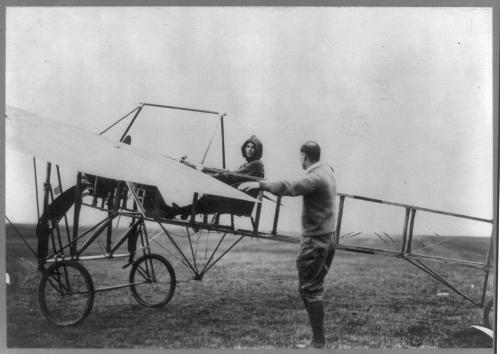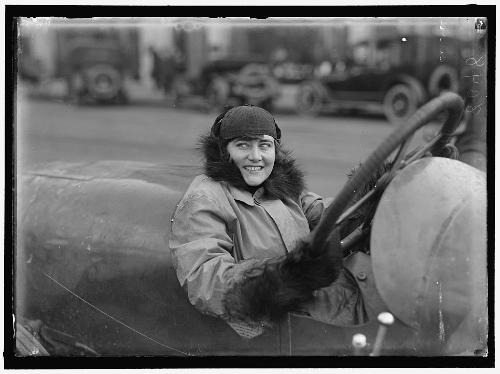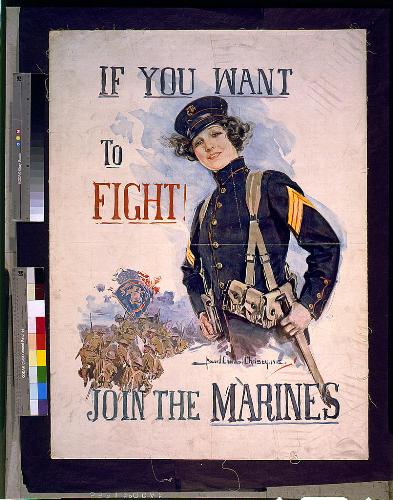Analysis of Vintage Genderforkery
By Bobster
WTF? Two beautiful women on a sailboat, one wearing men’s clothing. They gaze lovingly into each other’s eyes, about to kiss. A typical butch/femme scene, except it was made in 1902.
Or how about this one, made in 1923? It’s called ‘In the Girl’s Dormitory.’ The woman on the left is in full drag, right down to the pants, shoes and tie. They’re sitting on a bed, holding hands, smiling broadly at the camera. Not hard to figure what’s going to happen next.
We tend to think that queer history began with Stonewall in 1969, but of course that’s not true. It takes a lot of detective work to uncover our history, though. Pieces can be found in old newspaper stories about raids on gay bars, or fliers advertising a drag ball in Harlem. The book ‘Gay New York’ by George Chauncey is a masterpiece of reporting, as he ferrets out the city’s queer history using fragments like these.
The Library of Congress is where I discovered these old gender-bending photos. But other than the photo’s title and date, there’s usually no other detail given. The viewer is left to guess at the photo’s meaning and intent.
Both of those photos were studio portraits, not snapshots. The ‘Dormitory’ photo is from a stereo card, which produced an illusion of 3-D when viewed through a stereoscope. So they clearly weren’t made with a queer audience in mind. Why did someone create obviously androgynous images for a general audience?
Perhaps a clue can be found by looking at the changes in society going on around the turn of the 20th century and following decades. The Victorian era was ending, and many women were challenging the established roles assumed by the ‘weaker sex.’ The women’s suffrage movement was gathering steam in both the U.S. and Britain, shattering the illusion of females as delicate creatures too docile to march in the streets and demand the right to vote.
This magazine cover from 1895 satirizes the trend with an illustration of a young woman in short hair fully dressed in men’s clothing. Her mother is saying, ‘Goodness me, Kitty! Don’t stand there with your hands in your pocket that way – you don’t know how ungentlemanly that looks!’
Along the same lines is this stereo card image from 1901 entitled ‘The New Woman – Wash Day,’ which shows a woman in drag and smoking a cigarette. Her husband is wearing an apron and hand washing the laundry.
They may be intended as humorous, but these images also reflect a backlash against the restive women of the era. If women were allowed to take on roles that traditionally were reserved for men, then weren’t men doomed to assume the feminine roles of the ‘fairer sex?’ Let women vote, and soon men will be scrubbing floors while women left the home to run the world!
Amid this upheaval in gender roles, there may also have been a queer sub-context to many of these images. Although few people knew lesbians even existed (sodomy laws usually only referred to men) same-sex women couples known as ‘Boston Marriages’ were becoming known in the late 19th century. These women tended to be middle- and upper-class, generally better educated and living in cities. The Boston Marriage allowed women an independence from men that must have made some men – and women too – pretty nervous. These relationships were tolerated at the time because they were relatively few in number and assumed to be non-sexual romantic friendships, although many of them were undoubtedly sexual.
One woman in a Boston Marriage was Frances Benjamin Johnston. She became one of the most successful photographers of her era, doing portraits of Theodore Roosevelt, Andrew Carnegie, William McKinley, and many other famous people of the day.
Johnston’s business partner and presumed lover, Mattie Edwards Hewitt, was a successful freelance home and garden photographer. In 1913 she and Johnston opened a studio together in New York, and in the 1920s they photographed New York architecture together. Johnston continued to photograph until her death in New Orleans at age eighty-eight, according to GLBTQ.com.
Among Johnston’s photographs found in the Library of Congress is this one showing Johnston and another woman in drag, with a third woman dressed in traditional female clothing. My guess is that this self-portrait was done on a lark, and unlike her more famous portraits was just created for the couple and their friends who knew of their queer relationship.
While there certainly were lesbian relationships in all social classes, the women in Boston Marriages had social connections that enabled them to influence the writers, artists and photographers that helped shape public opinion around the turn of the century.
Were other of these gender-bending photos of the era produced by queer photographers? My guess is that some of them were. It certainly would be a way of expressing a queer sensibility under the guise of producing entertainment for the masses, at a time when queer expressions were practically unheard of in ‘polite company.’
By the time of the First World War, more women were being photographed engaged in ‘male’ pursuits such as aviation and auto racing in which they wore masculine attire. As a sign of how common these images had become, the government began using women dressed as soldiers and sailors in their recruiting ads.
But while images of women in men’s clothing can be found in the Library of Congress, the reverse seems to be pretty rare. So far, I’ve uncovered only one: an advertisement for a female impersonator, dated 1896. But I’m still looking!
About Bobster
Bobster is a freelance writer living in Honolulu, Hawaii. His Flickr account is here.
Category: your voice 15 comments »















January 19th, 2009 at 8:21 am |
This post is amazing. I LOVE these photographs and am thinking about printing them out and having them framed. How gorgeous.
It’s silly for people to assume that queer history began with Stonewall. Queers have been around for as long has people have. Queer activity has, too (Ancient Greek bathhouses, anyone?). It’s such a treat to find proof of it.
Thank you for this!
[Reply]
January 19th, 2009 at 8:48 am |
Fantastic lesson in genderqueer (and LGBT) history.
[Reply]
January 19th, 2009 at 10:02 am |
Wow! This stuff… all of it is amazing. Utterly incredible. It is such a gift for me to be able to see these beautiful and handsome queers, dressed up so immaculately, being their beautiful radical selves so long before Stonewall – thank you for this! It is amazing, and total candy for the eyes and the heart.
[Reply]
January 19th, 2009 at 10:41 am |
I’m an illustrator and I absolutely *love* early illustrations and photography of genderqueer culture. Our history most definitely goes way beyond something as recent as Stonewall. Thank you for posting these!
@Britni: I studied ancient Greek history at Uni, so I know what you’re talking about. Cult of Cybele anyone? :)
[Reply]
January 19th, 2009 at 11:52 am |
Great finds, and good analysis.
There’s a long history of gender weirdness, but it is usually confined within the context of a joke or play, not a part of everyday life. E.g. English pantomime, or the Harvard Hasty Pudding show.
Marjorie Garber’s _Vested Interests_, 1997 is a great read on the subject.
I also came across an image in a book on the Moulin Rouge theatre in Paris which included an image of a girl petting a mannishly-dressed young woman, circa 1910s or 1920s
[Reply]
January 19th, 2009 at 1:02 pm |
Awesome.
[Reply]
January 19th, 2009 at 3:43 pm |
Fabulous, my favorite subject!
Some more excellent reads:
Surpassing the Love of Men by Faderman (my favorite, but more about lesbians in lit. than gender. Also Odd Girls and Twilight Lovers)
Women in Pants: Manly Maidens, Cowgirls, and Other Renegades by Catherine Smith and Cynthia Greig (amazing images)
A Desired Past: A Short History of Same-Sex Love in America (quick and readable)
and for some really entertaining reading, The Collector’s Edition of Victorian Lesbian Erotica which is absolutely ridiculous and full of gender bending (as well as incest, S&M, and everything else you might expect from stuff like this)
[Reply]
January 20th, 2009 at 12:38 am |
i absolutely love these old pictures, and it’s facinating to read a little about the background behind them as well, i particularly love the one of the woman in the car, a beatiful portrait in its own right…..
[Reply]
January 20th, 2009 at 10:22 am |
I’m not sure, but in the third picture, it looks like they’re doing the Charleston. Don’t you think?
[Reply]
January 20th, 2009 at 10:29 am |
The woman on the left (in the photo of the women dancing) reminds me of Zooey Deschanel.
[Reply]
September 4th, 2009 at 12:05 am |
This was BEAUTIFUL!!!! My heart just soared. Thanks for taking the time to post these. :)
[Reply]
September 4th, 2009 at 10:59 am |
How in the world did I miss this article? LOVE IT BOB!
[Reply]
October 16th, 2009 at 11:36 am |
bless this post with love,peace,respect and success.
just let love be
[Reply]
October 6th, 2010 at 12:29 pm |
Wow, I learned quite a bit from this. Thanks for a great article, Bobster!
[Reply]
October 7th, 2010 at 11:54 am |
great post – learned a lot
[Reply]